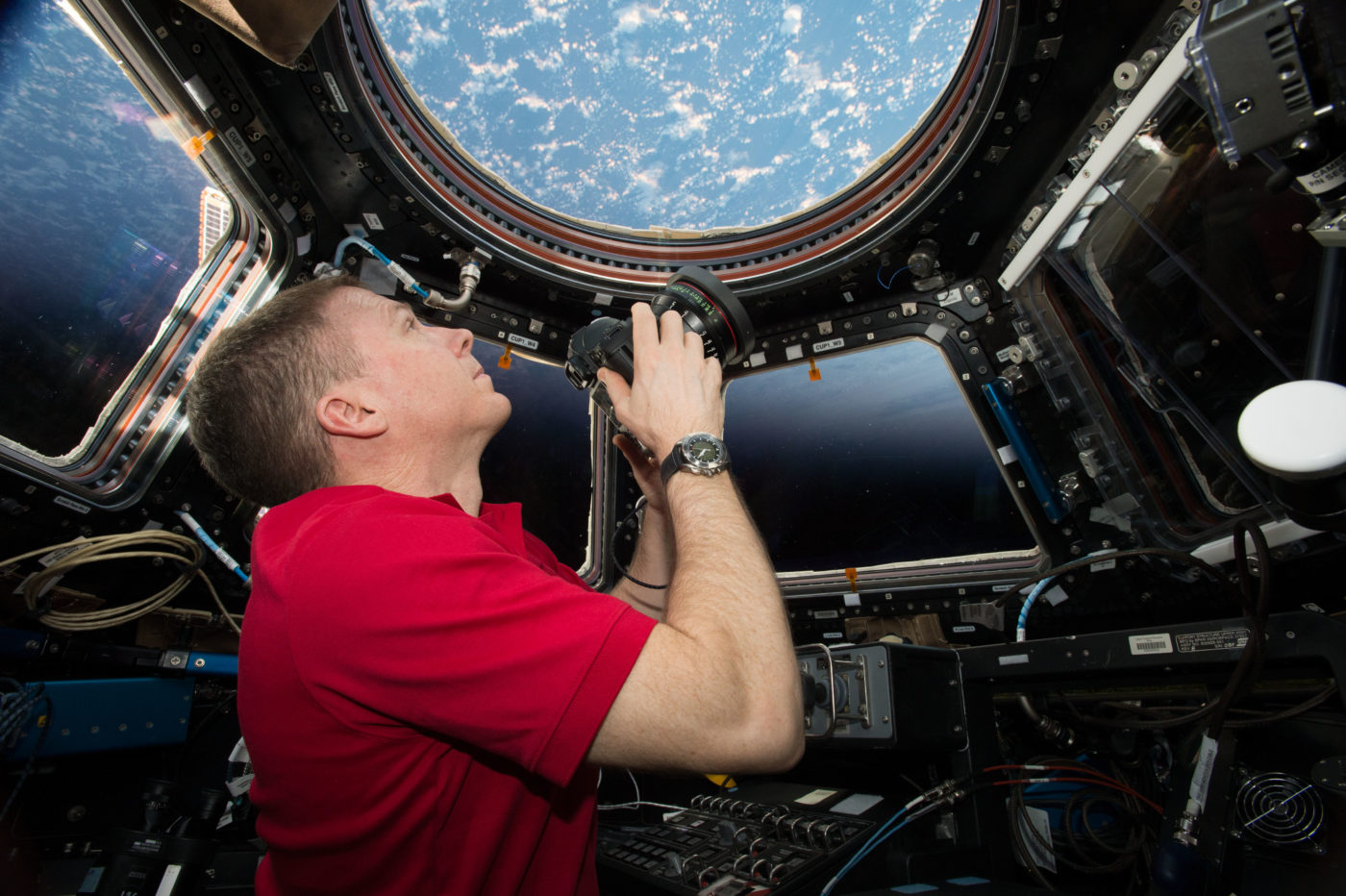
NASA Commander Terry Virts with Canon 1D C at the window of the International Space Station’s Cupola Observation Module. Photo onboard the International Space Station (ISS) courtesy of NASA.
The IMAX production A Beautiful Planet opened in theaters on April 29. One day earlier, I discussed its technique and technology with James Neihouse, ASC and Marsha Ivins, along with Tim Smith and Leigh Nofi of Canon. James was driving on I-95 in Florida. Marsha was at home in Houston, Texas.
Marsha Ivins, former NASA Astronaut who flew on five Space Shuttle missions, was a consultant on the film, coordinating with NASA and IMAX. Toni Myers wrote, produced and directed. Jennifer Lawrence narrated.
James Neihouse, with more than 30 IMAX film credits, trained the Astronauts in cinematography, as he has done on more than 25 other Shuttle and Space Station missions. As Variety wrote, “Short of putting Emmanuel Lubezki through Astronaut training, it’s difficult to imagine more rapturously beautiful images of the Earth from orbit than those supplied by A Beautiful Planet, the latest collaboration between IMAX and NASA.”
This was the first IMAX feature in space to use digital cameras: Canon EOS C500 4K Digital Cinema Camera and Canon EOS 1D C 4K DSLR. The cameras were delivered from Earth to the International Space Station (ISS) in September 2014 on an unmanned SpaceX Dragon. The Astronauts took turns as DPs: NASA Astronauts Terry Virts, Kjell Lindgren, Butch Wilmore, and Scott Kelly; European Space Agency Astronaut Samantha Cristoforetti; and Japan Aerospace Exploration Agency (JAXA) Astronaut Kimiya Yui.
In the film, daily life aboard the ISS is punctuated by spectacular scenes: lightning storms, volcanoes, coral reefs, the Aurora Borealis dancing in breathtaking high resolution. Other images are ominous: glaringly bright city lights, drought, deforestation, and the effects of climate change worldwide.
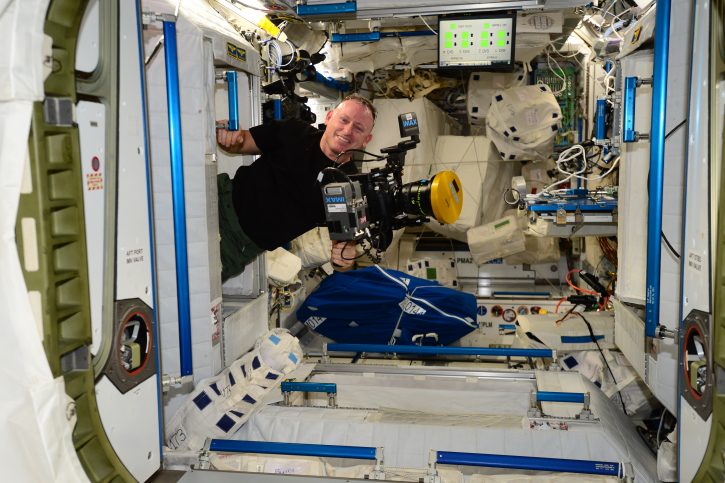
The first view in space of the the IMAX-Canon C500-Codex camera rig, with ARRI/ZEISS 12mm T1.3 Master Prime, after NASA Commander Barry (Butch) Wilmore assembled it for the first time. Photo courtesy NASA.
Quick Technical summary: Three Canon EOS C500 4K Digital Cinema Cameras and two EOS-1D C cameras were sent to the ISS. They were used one at a time. The C500 has a 16:9 S35, 8.85-mega- pixel (4096 x 2160) CMOS image sensor that records to internal CompactFlash cards and simultaneously outputs uncompressed RAW. RAW Data was recorded onto a Codex Onboard S Plus recorder. The Canon EOS-1D C Digital SLR camera has a 5208 x 3477 pixel CMOS sensor for Full Frame Stills, and also shoots motion JPEG compressed 4K video (4096 x 2160).
JON FAUER: Thanks for taking the time to join this conversation. Jim, please tell me about the camera equipment used on A Beautiful Planet, why you chose it, and how.
JAMES NEIHOUSE: When we first started this whole process, NASA told us we couldn’t make the film…on film. “You’re not going to be able to fly actual motion picture film,” they said. “No more IMAX film because we don’t have a Space Shuttle to fly up and back.” (One 1200’ roll of 65mm/15-perf IMAX motion picture film weighs 12 lb and runs a mere 90 seconds). This time, they would use the SpaceX Dragon to get things back and forth. So we had to pick digital cameras.
We started the search about four years ago—looking for something that would come close to what real IMAX looks like. We rounded up a bunch of the best cameras at the time and ultimately picked the Canon C500 because it looked best overall. It had uncompressed 4K output and I felt that we needed every bit of data we could get from the camera to try to match IMAX. To record uncompressed RAW from the C500, we used the Codex S Plus onboard recorder.
We also picked the Canon EOS-1D C to use as a full frame still camera, with 5K resolution (5208 x 3477 effective pixels). Its full frame 1.5:1 aspect ratio came fairly close to the 1.44:1 IMAX aspect ratio, and has 16-bit color space. The 1D C was used to take multiple exposure image sequences that we converted to real time, 24 fps motion with secret sauces in post production. Th e other reason I picked the 1D C was that it had a 4K in-camera Motion JPEG video recording option. I felt it would be good to have a very small camera body that enabled us to get into tight places, even if it was compressed. So we had two Canon full motion systems. Above all, I wanted the Canon optics. I love the Canon glass—it is just beautiful.
Marsha, I heard that you had to rework the plexi window that the Astronauts were shooting through. Can you tell us about that, please?
MARSHA: We started building the ISS in 2000, and we carried each module to be added to the ISS in the cargo bay of the Shuttle, one at a time. The Cupola was put on board in 2010. The Cupola is a module that consists of 7 windows—six circumferential and one nadir (center) window facing Earth. It has nice, lovely, optical glass that NASA then covered with cheap, non-optical Plexiglas in order to protect the real glass. Over the years that the module has been in space, the Plexiglas covers have been bumped and scratched. Because it’s such a so material, it is easily scratched and difficult to clean. When there’s dirt and grime on it, and then you try to clean it, you basically scratch it more. Shooting any picture through one of those windows reveals all the scratches.
So, in order to save IMAX an arm and a leg in post-production costs trying to remove scratches digitally—many of which they probably couldn’t have taken out anyway—we asked NASA if it would be possible to design and fly a new protection for the windows that allows you access to the real window for shooting. We had the NASA engineers basically design it: they told us the material, the thickness, the kind of fasteners that would be needed, what the opening should be, and so on. We had the thermal people bless it. We had everybody who would have done the NASA design get involved, but then we had IMAX build it. We had it certified as a piece of payload hardware, which was how we flew the cameras. We had it manifested to launch. Then we got the crew some time for installation. It’s still in place. They continue shooting regular NASA stuff through it now.
When shooting through the Cupola, do you have to put something like a mattebox anti-reflection donut ring around the front of the lens?
MARSHA: All of the lenses that NASA allows on orbit, and that includes payload and regular NASA equipment, are protected with a bump shield on the front. That’s a protective covering around the rim of the lens—so the metal of the lens doesn’t actually ever touch a window. We also managed reflections with a fabric shroud that basically covered the whole window. It had a hole in the center and the lens went through the hole and it blocked reflections. Part of the problem is that each window onboard the space station is actually four panes of glass, so any light coming through the window is going to bounce around in between those four panes of glass and you get a lot of reflections even if you think you have blocked your light off through that window. But that’s standard procedure for NASA. We just built these things for our cameras, and now NASA owns them.
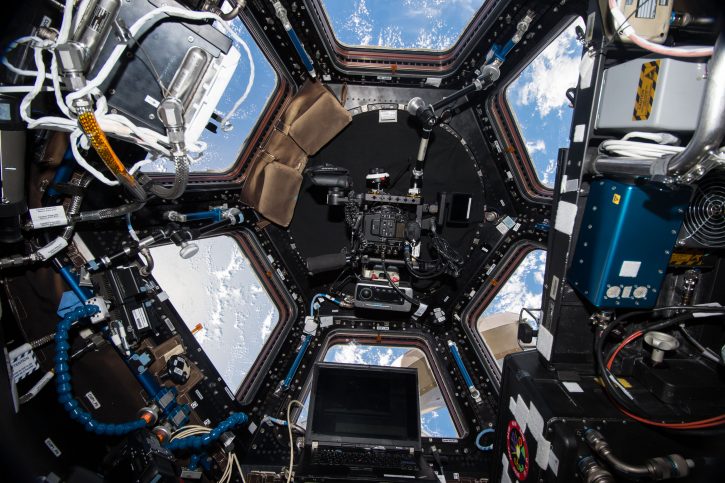
MAX C500 camera shooting through the nadir window in the Cupola using a black fabric anti-reflective window shroud. Photo: NASA
It sounds similar to what we might use here on Earth. Drape everything in Duvetyne and cut little holes for the lens.
JAMES: Much the same idea.
Tell me about the lenses that were used?
JAMES: We had an ARRI/ZEISS 12mm T1.3 Master Prime for the C500, with a PL mount. We also had the Canon CN-PL 15.5- 47 T2.8 L S Compact Cinema Zoom in PL mount for that camera. We flew the Canon Cinema Prime CN-E 14mm T3.1 L F and CN- E24mm T1.5 L F in EF mount for the 1D C camera. We also put a Nikon adapter in the kit so that, if the need arose, they could use the older manual iris Nikon lenses that were already onboard.
How did the Astronauts determine exposure?
JAMES: For the 1D C, they would pretty much use the camera’s internal meter…and…sorry, I just have to stop for gas. (While re- fueling, James continued…) I taught them how to evaluate exposure during training sessions. With the C500, we used the waveform monitor that’s built into the camera system. We worked with Tim Smith a lot on figuring out the best exposure to retain the highlights and make sure we had enough light in the shadows.
Did the Astronauts calculate their own exposures from the waveform monitor or did you control it from Earth?
JAMES: It was all done by them onboard. They would occasionally get in touch with us and ask for suggestions on difficult shots. But they had physical control of the lenses and the cameras all the time.
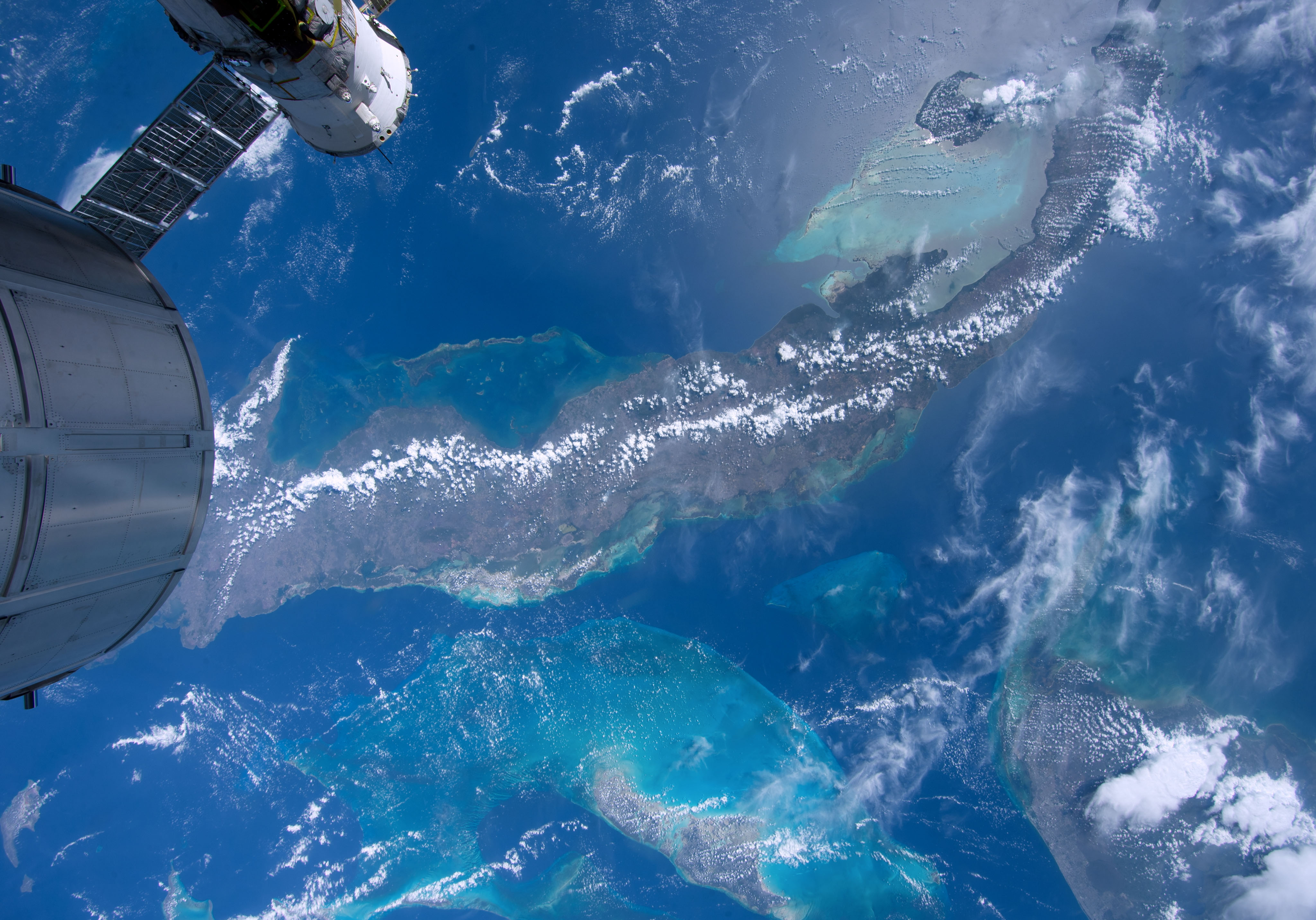
View of New Zealand from the ISS. Photo © 2016 IMAX Corp.
That leads to an interesting question. How do you teach Astronauts to be DPs? I imagine it’s probably much harder to teach a DP to be an Astronaut.
JAMES: You give them a camera and once they learn the buttonology of the camera — where the record button is and how to get data out it, it’s pretty much just letting them go through the training and shooting some test footage. We made suggestions for framing, scene length, and lighting. They shot some test footage. We screened their tests in an IMAX theater and let them watch it. They learned quickly what was right and what was wrong. It was pretty clear on that big IMAX screen what didn’t work well. Marsha’s had experience as an Astronaut in space multiple times, so she can speak to the other end of that equation.
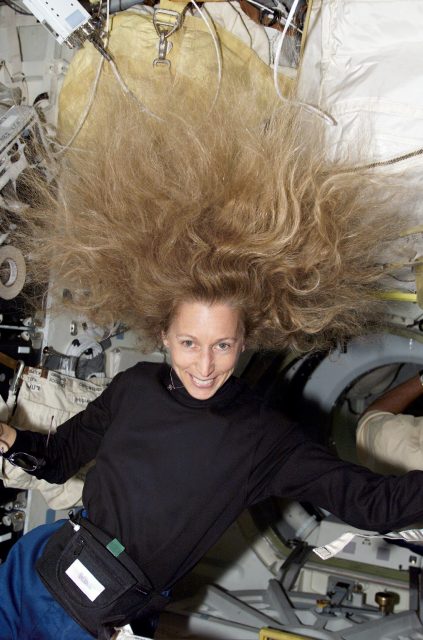
Marsha Ivins during her 5th Shuttle mission, STS-98, February 2001 with Zero-Gravity hair. Photo: NASA.
MARSHA: Part of what every Astronaut goes through in training is how to take pictures. But because it’s not considered essential or critical to the mission, for the most part, some Astronauts take it very seriously and some don’t. Everybody is given basic lessons: “Here’s the end you shoot through and here is where the card goes in.” Back in the olden days, it was also, “Here’s where the film goes.” Shooting with a camera for an IMAX movie, however, requires a whole different level of training. What James and Toni Myers provided was the context of shooting pictures for an IMAX screen. Learning all that is like getting lessons in advanced photography. Greg Smith was our sound guy, and he spent a few hours with the crew talking about the basics of sound and then did the same kind of training that James did with the cameras. The Astronaut crew has to be the director, the cinematographer, photographer, gaffer, grip, and sound recordist. They also are the actors. So, they’ve got to take on all of those roles with very little training, and it’s quite miraculous that it all happens.
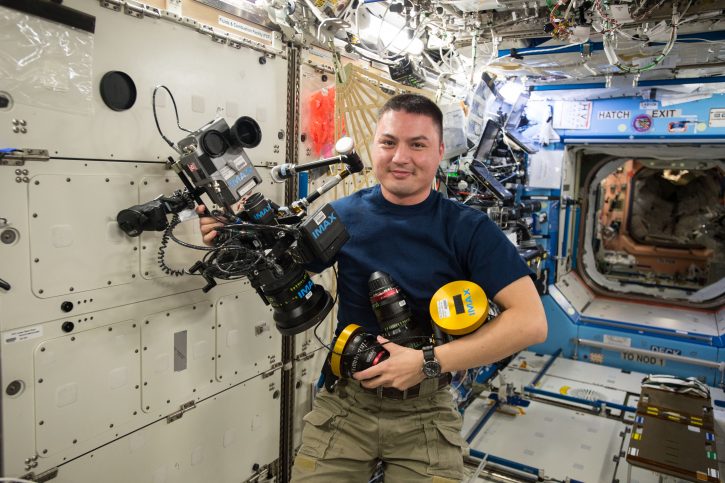
Onboard the International Space Station, NASA astronaut Kjell Lindgren holds an IMAX-Canon C500-Codex camera with ARRI/ZEISS 12mm T1.3 Master Prime and fistful of lenses: Canon CN-E 15.5-47mm T2.8 Compact Cinema Zoom, Canon Cinema Prime CN-E 14mm T3.1 L F and CN-E24mm T1.5 L F used in filming “A Beautiful Planet.” Photo courtesy of NASA.
I guess the Astronauts also worked as the DITs, camera assistants, production drivers, and crane services. Tell me more about the sound. Did you have external audio recorders?
JAMES: Years ago, it began with cassette tapes, then we moved to DAT, next to CF cards and on this flight we recorded straight into the C500 camera. We couldn’t record audio directly onto the Codex when we were just doing sound. We’d record onto CF cards. The great thing about the C500 is that you could load CF cards in it, and simultaneously while the Codex records 4K RAW images, you could record proxies internally in the C500 at the same time with sound. They could transmit those proxies down to us a lot easier than getting the 4K material down, so that was how we kept track of what they were shooting. They recorded wild sound internally on the C500, without the RAW Codex. They would do a voice slate, “this is the sound of the toilet flushing”…or “this is the sound of the airlock closing” or “the sound of the helmet going on a space suit.” I think we got a pretty amazing soundtrack and it comes across nicely in the new IMAX theaters’ 12.0 sound system.
If the IMAX aspect ratio is 1.44:1, how did you define the framelines?
JAMES: In post, we just shaved a few pixels off the sides from the 1D C camera’s native 1:50 aspect ratio. That’s one of the reasons we picked it, losing the least amount of resolution. On the C500, after seeing some of the first tests on the big screen, we made the choice not to blow it up to the full IMAX aspect ratio. All the scenes on the C500 are shot and exhibited in the native 16:9 aspect ratio, letterboxed.
Most people, I think, have never noticed that there’s a difference. Mainly, the C500 was primarily used for interiors, inside the Space Station. The 1D C was primarily used for exteriors, shooting through the Cupola. Because you’re changing environments so radically, I don’t think anybody really notices the aspect ratio change.
What special preparations were needed for the cameras and lenses to work in space?
JAMES: There’s really not much we did for the cameras. They all had to go through flight certification, making sure that the electronics didn’t interfere with anything, that there were no sharp edges, nor any bad odors or gasses coming out of them in a space environment. Some of the cables had to be wrapped in Teflon tape to prevent flammability. Marsha, what else did we do for certification?
MARSHA: You programmed out some functions of the Codex menu.
JAMES: Yes, we actually Astronaut-proofed the Codex Recorders so that they couldn’t get into the menus and set things in odd ways. We also fixed it so they couldn’t delete anything off the Capture Drives (Codex media). Codex was really nice in rewriting the user interface for us and included an extra selection for presets. We actually had three presets: normal 24 fps, slow speed and high speed. We didn’t want the Astronauts to get deep into a menu situation that would require a lot of air to ground communication.
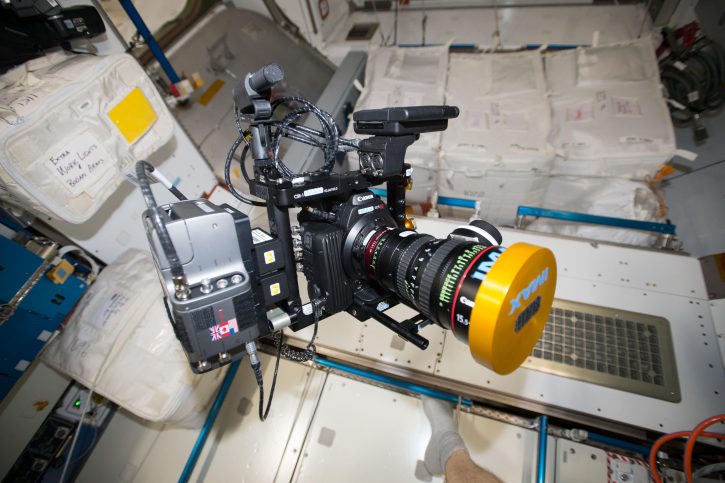
Canon C500 camera, Canon 15.5-47 T2.8 Zoom and Codex S Recorder. Photo: NASA
How did you manage data wrangling and get the data back to earth?
JAMES: Marsha’s the data queen.
MARSHA: All digital imagery that comes down from the Space Station—whether it was ours, any other payload, or regular NASA stuff—comes down through the Ku band antennae on a 300 or 500 megabyte per second data stream. It’s the same band that carries all communications, live video, audio—everything comes down on that pipeline. We basically just got in the queue. The crew is trained, when they take imagery, to take out the CF card, put it into an onboard laptop computer and transfer the imagery to whatever file they’ve been told to put it in. If it’s coming down as earth observations, it goes into one file. If it’s coming down as a payload, it goes into the payload file. There was an IMAX file in the payload’s folder and the crew simply moved the imagery into there and walked away. There are three or four dozen laptop computers onboard. The crew can put their CF cards into any laptop they want and transfer the data. Then the ground downloads these files. We took our spot in line. When our stuff came down, we were alerted because it was flagged as proprietary to IMAX and didn’t get distributed anywhere. It went onto a server that had been set up between the Johnson Space Center Imagery Department and IMAX directly.
What about the Codex uncompressed material?
MARSHA: Codex uncompressed data was recorded onto Codex 512 gigabyte Capture Drives that are about the size of two smartphones stacked together. Those went up and down with SpaceX’s Dragon vehicle, which is the only US spacecraft that can do an intact entry. Meaning it doesn’t burn up when it comes down through the atmosphere. So any hardware that NASA needs to send up and down gets onto that particular vehicle. Finding room on it is a matter of priority, but our agreement with NASA said that our drives would go back and forth. Each time a Dragon arrived to the space station, the drives would be placed onboard and returned to Earth. James would pick them up and they’d go to Codex where they’d get dumped and looked at. And then they’d be “scrubbed,” sent back to Houston, and then we’d send them on the next Dragon. We had 12 drives onboard and we had probably three or four in the up and down cycle at any one time. After Dragon had a problem where they lost a vehicle, one of our cameras was destroyed. We were sending up a replacement 1D C camera and no drives were on that flight. But that was the way home for the remaining drives at the end of our movie.
James and I went to Codex and we asked them how we could actually try to get that amount of data off of a hard drive—it’s a significant amount of data—onto a laptop and then transmit it back to Earth. There was no straightforward procedure at the time. It required that we change an IP address on one of the onboard laptop computers. That’s as significant as trying to move a solar array to a different module. It’s a big deal. I gathered up all the people that had a say in the software, the people who did the transfers, and the people who handled onboard laptop computers and demonstrated that we could do it. And they demonstrated that it could be done. Then James asked, “Well, can they do it from the ground?” Good question. I asked and they said, “Yeah, we can do it from the ground. All the crew has to do is plug it in.” And so that’s what happened over about a six week period. I would sit in one of the back rooms in mission control at 3:00 or 4:00 in the morning with the console operator. The crew was told which drive to put in, and every couple of hours we’d call them and ask them to swap out the battery. We managed to bring down 1.5 terabytes of data. We brought down every bit of data on all of the remaining Codex hard drives without a single bit lost.
Recently, I believe Codex has come up with a transfer dock that you can just plug into a laptop now with new software. Perhaps you were partly responsible for those new products?
MARSHA: Any change in a space station laptop almost requires an act of Congress. The application may be simple, but the approval process would have been the same.
JAMES: And that wasn’t available at the time we flew. NASA doesn’t keep up with the latest computer operating systems. It takes a long time for one to get vetted well enough for them to change out. I think they just recently went to Windows 7.
I’m not quite sure I understand how the 1D C camera was used. It shot stills and you combined them into video sequences?
JAMES: That’s correct. 99% of the Earth scenes were shot as image sequences of stills, four frames per second. They weren’t just stitched together. They were carefully processed using sophisticated software that recreated the missing frames to create a 24 frame per second full motion sequence. We used all the resolution from the full frame sensor.
On the C500, what ISO and frame rate were you shooting at most of the time?
JAMES: Almost everything was shot at 850 ISO. I think the highest ISO we had on a few shots was 10,000. These were scenes with lightning at night and some interior sleeping sequences. The C500 frame rate was 24 fps.
Did the cameras come back to earth or are they still up there in the ISS?
MARSHA: The cameras have been destructively disposed of.
JAMES: All except one. It’s signed and was shown at NAB.
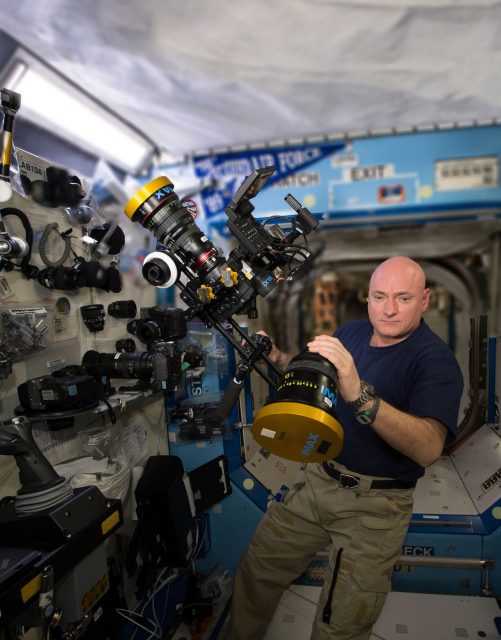
NASA Astronaut Scott Kelly with C500, 15.5-47 T2.8 Zoom, and ARRI/ZEISS Master Prime 12mm. Photo: NASA.
The rest were disposed of? Why?
MARSHA: One body came home but we were unable to return any of the other hardware. We’re waiting on the remaining Codex drives and CF cards that are slated to come home on the Space X Dragon that is currently docked at the space station. (Since this interview, they have successfully received all of our remaining Codex hard drives and CF cards.) Our last little bag of hardware, which has two camera bodies, two small lenses and a Codex, has been positioned inside the Orbital ATK Cygnus vehicle that will burn up on entry. So no, we were not able to bring any of those home. (Marsha sent an update on June 22: “ This was actually completed about 3 hours ago, so truly gone now for sure!”)
What about all those expensive lenses?
JAMES: Gone.
Ouch. Users and rental houses will cringe. But viewers of A Beautiful Planet will applaud the magnificent work in this production.
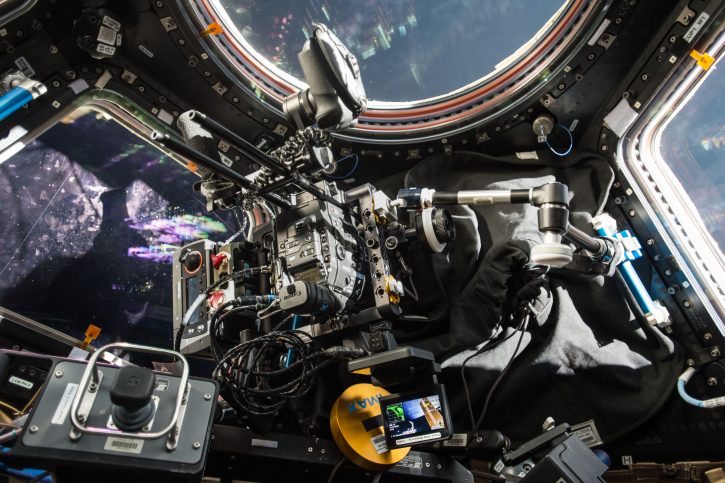
The C500 is secured to the wall with Magic Arms (formerly from Bogen, now Manfrotto). One end attaches to the 1⁄4-20 thread on the camera and the other end fits into the “seat track” – a running set of rails to which the arms can be mounted anywhere in the ISS. Photo: NASA
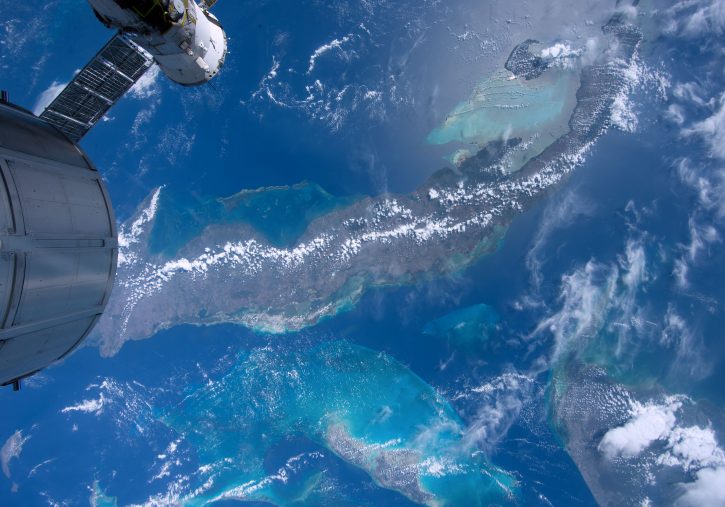
View from ISS of Bahama reefs. Photo © 2016 IMAX Corp.
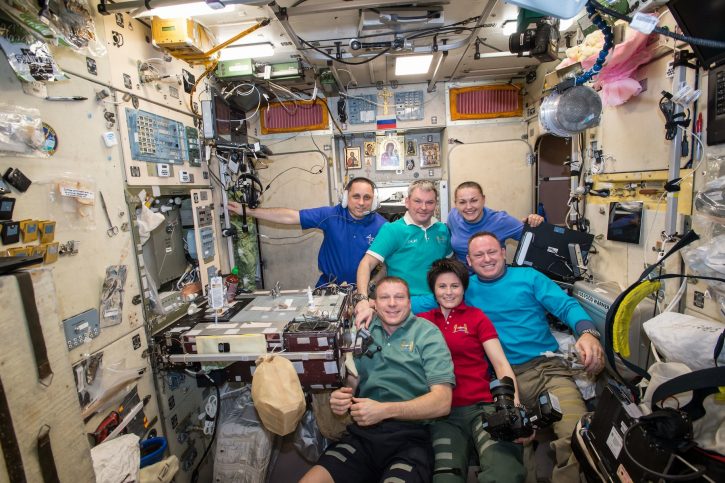
ISS Expedition 42/43 crew: (Top L-R) Russian Federal Space Agency (RSA) Cosmonauts Anton Shkaplerov, Alexander Samoukutyaev, Elena Serova; (Bottom L-R) NASA Commander Terry Virts, European Space Agency (ESA) Astronaut Samantha Cristoforetti, NASA’s Barry (Butch) Wilmore. Photo: NASA
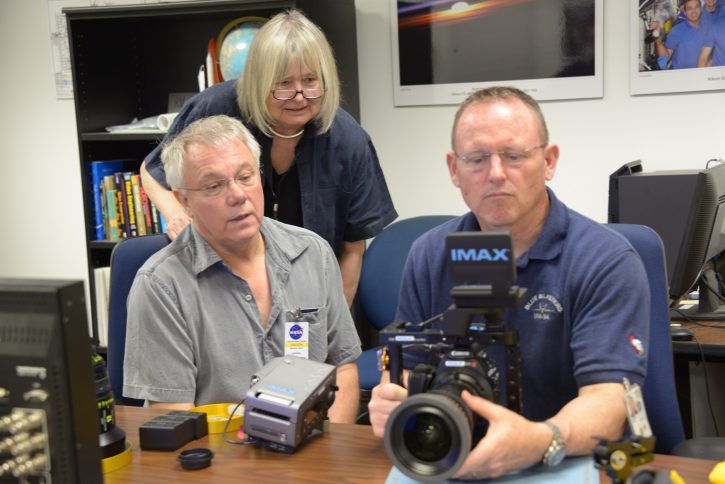
Director of Photography/Astronaut Training Manager James Neihouse, Writer/Director Toni Myers and Commander Barry (“Butch”) Wilmore during an IMAX camera training session at NASA’s Johnson Space Center, Houston, Texas. Photo by Marsha Ivins © 2016 IMAX Corp.
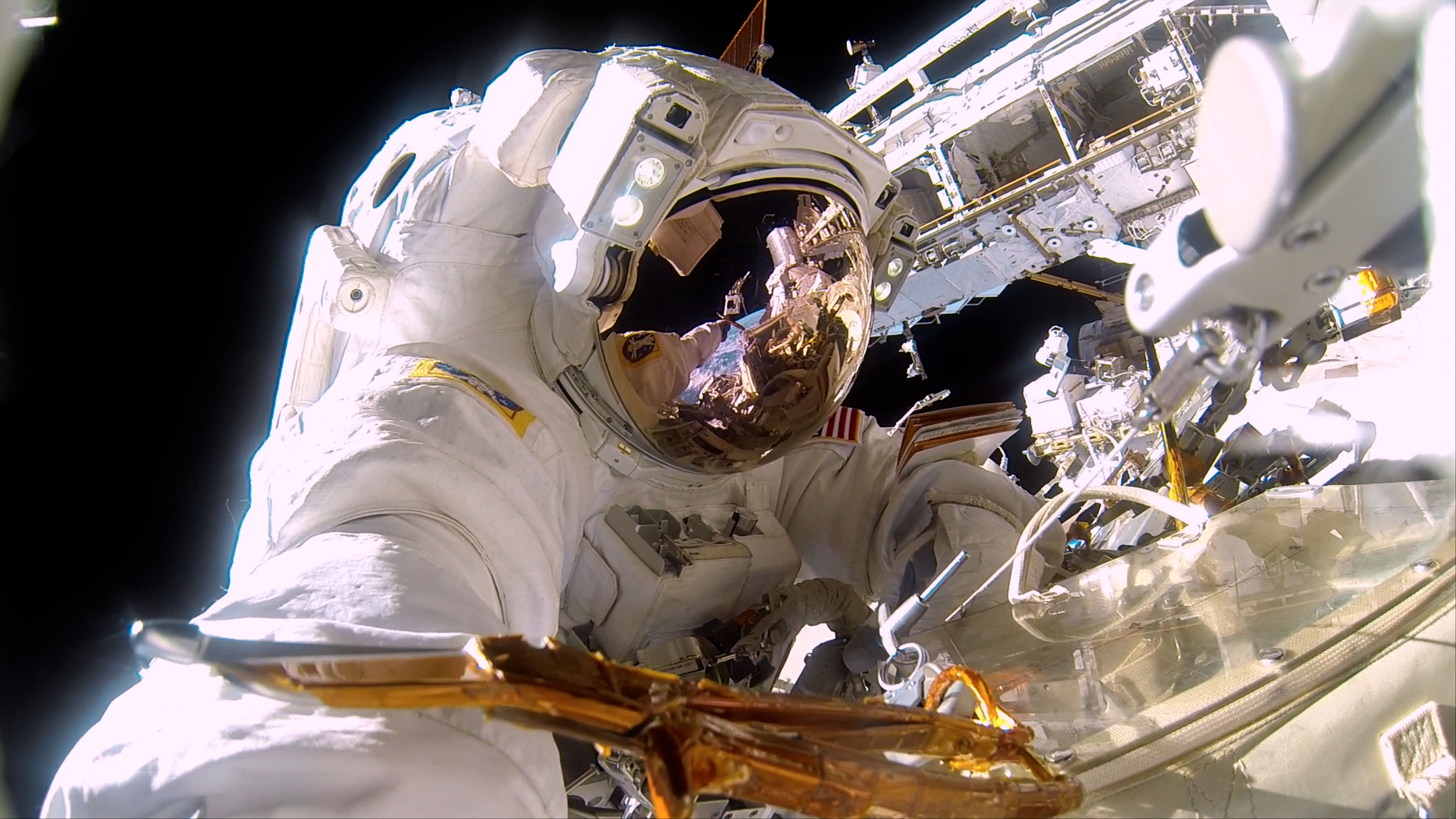
At left: NASA Commander Barry (Butch) Willmore on a spacewalk to repair the exterior of the International Space Station. It’s almost 300° on the sun side of the space station and -275° in the shade. Photo courtesy of NASA.








